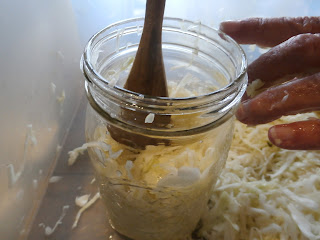I began by shredding 3 heads of cabbage on a mandoline cutter. I probably had 8 or 9 pounds of cabbage. (Be sure to reserve a few whole cabbage leaves. You’ll see why later.) You could use a sharp knife or a food processing to achieve the same results. The shreds are thin but not super thin like angel hair coleslaw. Then I mixed in 5 tablespoons of pickling/canning salt with my hands, massaging the shredded cabbage to bruise and break it up, and get the salt mixed all through. This is an important step because it starts the cabbage juices flowing, which is what you need in the kraut.
Next I put it into quart wide-mouth mason jars and tamped it down really well with a wooden spoon. This further bruises the cabbage and creates even more juice. I was amazed at how much juice came out in just a few minutes of this! I packed and packed it to about 3/4 full in the jars. Then, I carefully placed the whole cabbage leaves, torn to fit, on top of the shredded cabbage. I tucked it in around the edges and pushed it down well so that the liquid was coming over the leaves.
The next step was to weight the cabbage down. I did this by filling half pint jelly jars with brine, putting on used lids and rings, and pushing them down onto the cabbage leaves. I put the 4 quarts of future kraut in a cake pan, took it to my closet, and set it in the floor of my closet, which is the coolest spot in the house. I covered it with a thick bath towel.
Waiting is the hardest part. I checked the kraut every day or so to make sure it was fermenting and not molding and to skim off any scum, which is actually kahm yeast. If mold had formed, I would have thrown it all out because mold is dangerous. The white scum of kham yeast, however, is not.
If the liquid begins to look like it’s not covering all the cabbage, then add more brine made from 1 quart of water and 1 1/2 tablespoons of salt. Stir until salt dissolves. Bring this mixture to a boil and remove from heat. Let it cool to room temperature before you add it to your kraut. You can store this in a jar to use anytime during the process. I made it while I was prepping the kraut and kept it on hand, but wound up not needing it for mine.
I began the ferment on September 27, 2016, and I was done on October 19, 2016. I could have left it longer but it had reached the degree of flavor we like. Not crazy sour or salty at all. Just a mild kraut flavor which is yummy eaten raw or cooked. You will want to ferment it from 2 to 6 weeks, depending on how you like the flavor. Just taste test it to see
I reserved some out for our dinner (of course!) then canned the rest. I got 5 pints of lovely homemade sauerkraut. Now, I know if you cook or can it, you destroy the probiotics. However, I’m in a situation where I need to store it in a shelf stable manner and for us, this means canning it. It’s only a 15 minute water bath for pints and I have 5 future meals on the shelf! If you have room in your refrigerator, this will store safely without canning it for many months.
Here are pictures of the kraut after it finished fermenting and in the pot to be simmered before canning. (Notice that the liquid level is very good over the kraut in the jars before canning.) I removed the large leaves that covered the kraut and discarded them.
Tada! 5 beautiful pints of homemade kraut fresh out of the water bath canner!
I cooked the reserved part up with some home canned, home smoked pork, and served it with boiled sweet potatoes, buttered and toasted rye bread, and pork n beans.











No comments:
Post a Comment